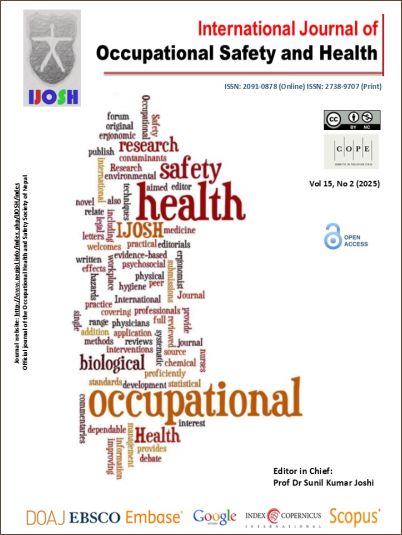Predictive modelling of whole-body vibration transmission through strategic locations of human body using artificial neural networks
DOI:
https://doi.org/10.3126/ijosh.v15i2.69773Keywords:
Whole Body Vibration, Vibration Transmissibility, Artificial Neural Network, Predictive Model, Seated Human BodyAbstract
Introduction: Modelling the seated human body's response to whole-body vibration poses a formidable challenge due to its intricate reliance on factors encompassing anthropometry, postures, and vibration characteristics. While lumped parameter models are prevalent in this domain, their fixed weight necessitates modifications. Hence, a novel biodynamic model utilizing artificial neural network methodology was devised to simulate transmitted vibrations across strategic locations of body segments in seated individuals, facilitated by field vibration data.
Methods: Employing a multilayer feed-forward neural network integrated with the back propagation algorithm, an optimal setup was explored. Data were collected from 52 adult male subjects. Mean square error (MSE) values were evaluated during the training, validation and testing phases to assess the performance of the model. The study also compared the model-predicted values to the actual values using four unseen datasets, which were reserved for evaluating the model's generalization performance.
Results: The neural network model achieved mean square error (MSE) values of 0.0015, 0.0030, and 0.0015, accompanied by regression (R) values of 0.992, 0.990, and 0.991 in training, validation, and testing, respectively. Comparison shows high accuracy between the model-predicted values and the actual values.
Conclusion: The well-trained artificial neural network demonstrated proficiency in forecasting vibration transmission along the vertical direction through different body parts of a seated human, based on parameters such as age, body mass index, posture, experience, seat-buttock interface clothing layer, frequency, and vibration intensity. The comparison between the model-predicted results and the experimental value affirmed high accuracy and reliability of the developed model.
Downloads
Downloads
Published
How to Cite
Issue
Section
License
Copyright (c) 2025 The Author(s)

This work is licensed under a Creative Commons Attribution-NonCommercial 4.0 International License.
This license enables reusers to distribute, remix, adapt, and build upon the material in any medium or format for noncommercial purposes only, and only so long as attribution is given to the creator.





